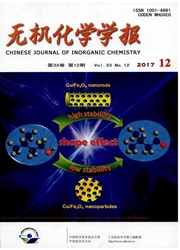

 中文摘要:
中文摘要:
采用原位合成的方法,在微波辐射条件下制备了样品NH4PW—NaY,并通过FTIR、XRD、低温氮吸附-脱附等手段确认了该样品为磷钨酸铵(NH4PW)存在于NaY沸石超笼中的“瓶中船”型催化剂。通过NH4PW与NOx反应生成磷钨酸fHPW)的方式将NH。PW—NaY转化为HPW—NaY,并通过红外及红外吡啶吸附等表征手段证实了NaY沸石超笼中只含有磷钨酸的“瓶中船”型催化剂HPW.NaY被首次制备。随后研究了该催化剂对NO,的吸附-脱附性能,结果表明,在吸附温度为170℃时,HPW—NaY对浓度为1696mg·m^-3的Nq吸附容量为2.38mgNO·gcnt^-1,在通水蒸汽条件下,催化剂温度降至100℃时所吸附的N嘎发生脱附,脱附后的催化剂可重复使用。最后通过程序升温脱附一质谱(TPD—MS)研究了HPW。NaY对NO。的催化分解性能,结果发现NOx在以NaY沸石为载体的HPW上的分解过程中有O2产生,且氧的产生滞后于N2O及N2,HPW-NaY催化分解NOx的转化率及N2选择性分别为61%与75%.均高于单纯HPW催化剂。
 英文摘要:
英文摘要:
The "ship-in-bottle" catalyst NH,PW-NaY was synthesized under microwave radiation and characterized by FTIR, XRD and low temperature N2 adsorption-desorption. HPW-NaY was produced from NH4PW-NaY by the in situ reaction of NH,PW with nitrogen oxides (NOx). FTIR and in situ pyridine adsorption IR confirmed that HPW-NaY with encaged HPW was prepared successfully for the first time. The NOx adsorption-desorption on HPW-NaY was investigated, and the results showed that 2.38 mgNo .g-1 was adsorbed at 170 ~C, and the adsorbed NOx could be desorbed under coding in wet air. After NO~ desorption, the HPW-NaY could be reused without regeneration. Finally, temperature-programmed desorption coupled with mass spectroscopy (TPD-MS) was carried out on HPW-NaY filled with NOx to probe into its ability to catalyze NOx decomposition. O2 formation was observed, which lags a little behind the appearance of N2O and N2 on HPW- NaY. The NOx conversion is 61% with N2 selectivity of 75%, which is higher than that on pure HPW.
 同期刊论文项目
同期刊论文项目
 同项目期刊论文
同项目期刊论文
 A combined TAP and in situ IR study of the NOx adsorption-decomposition over solid heteropoly compou
A combined TAP and in situ IR study of the NOx adsorption-decomposition over solid heteropoly compou 期刊信息
期刊信息
